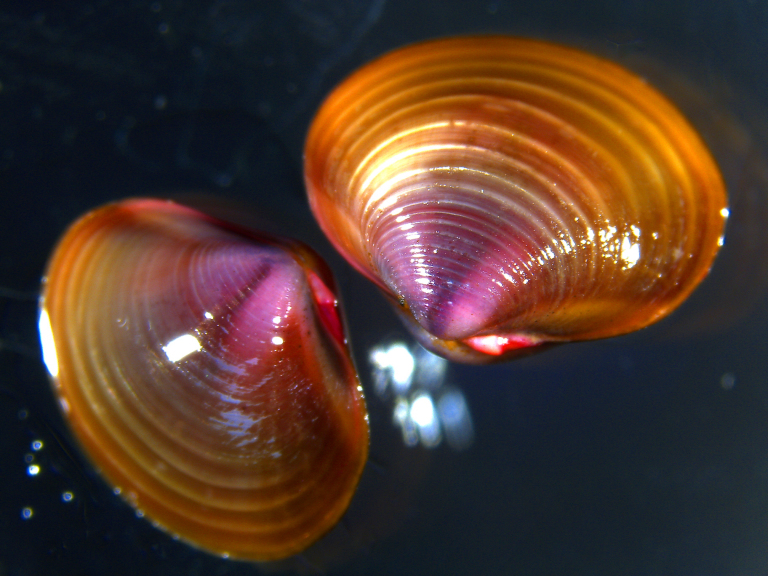
Report Date:
http://californiaoutdoorsqas.com
Question: What type of clams are in the Sacramento-San Joaquin Delta? I see the small blackish ones and sometimes a type of razor clam. I grew up using them for bait, but now I hear that people eat them. Are they safe to eat? Is there a season or limit on them? (Kathleen B.)
Answer: The types of clams found in the Sacramento-San Joaquin Delta are the Amur River clam (Corbula amurensis) and the Asian clam (Corbicula fluminea). The Amur River clam is found in saltier portions of the Delta, while the Asian clam inhabits freshwater sections. Both are safe to eat in accordance with safe-eating guidelines found in the 2017/2018 Freshwater Sport Fishing Regulations, beginning on page 45. A sport fishing license is required to harvest clams and the daily bag limit for clams taken in inland waters is 50 pounds in the shell (California Code of Regulations Title 14, section 5.20). The season is open all year and clams may only be taken by hand, or by spade, shovel, hoe, rake or other appliance operated by hand.
Please note that the Office of Environmental Health Hazard Assessment, which issues safe eating advisories, has a standing advisory from 2013 to avoid fish and shellfish from the Port of Stockton due to mercury and other chemicals in the water.
Which wildlife legally taken in other states can be brought into California?
Question: I know it is illegal to bring a legally taken mountain lion into California, but is it legal to bring a swan legally taken in Nevada into California? Is there a list of other wildlife which can be legally hunted in other states that cannot be transported into the state? (Leonard, Merced)
Answer: A very limited swan hunting season is authorized in Nevada by the annual federal Frameworks for Migratory Bird Hunting Regulations, published each year in the Federal Register under section 50 of the Code of Federal Regulations, Part 20. However, the same Framework does not authorize swan hunting in California. If the swan, or another bird or mammal was legally taken, a declaration of entry form is required to provide you with a document to cover the bird or mammal that may not be legal to hunt in California, pursuant to Fish and Game Code (FGC), section 2353. One copy of the declaration should be delivered to the U.S. Department of Agriculture entry point, one copy is mailed to the California Department of Fish and Wildlife (CDFW), one copy is delivered with the animal to a taxidermist (if you have it mounted) and one copy is kept for your records. The exception to this law is the mountain lion, which can be legally taken in some states but cannot be brought into California, pursuant to Proposition 117, enacted by the voters of California in 1990 and the subsequent FGC, section 4800.
In addition, fully protected mammals, such as bighorn sheep (except Nelson bighorn sheep, as authorized by the Commission for hunting), ring-tailed cat and wolverine, may not be taken or possessed at any time, pursuant to FGC, section 4700. However, a legally imported fully protected mammal may be possessed under a permit issued by CDFW.
What is the “safety zone”?
Question: I have been looking in the regulations and can’t find any language stating I can’t hunt near a road. The “safety zone” as referenced in the regulations does not specifically include “roads.” The only thing I can find pertaining to roads is that one cannot shoot from or across one. I ask because I belong to a hunting club that borders a public road. (Albert)
Answer: That is a very good and quite commonly asked question. Nothing in the FGC defines a specific no shoot buffer along public roads. However, according to FGC, section 3004 and Penal Code, section 374c, it is unlawful to discharge a firearm from on or over a “public road.” This term is defined as the area improved, designed or ordinarily used for vehicle travel pursuant to the California Vehicle Code, section 530. Although the FGC does not specifically define a safety zone other than what is referenced in section 3004 (see next question), your local county or municipality may have an ordinance that does. Thanks for your question, and stay safe.
Is a house considered “occupied” if no one is home?
Question: I have a question about the 150 yard safety zone and how it reads as “occupied.” I have some instances where there are cabins that are owned or leased on land within the Cleveland National Forest. Most are vacant almost all year long (emphasis during hunting season). If they are not “occupied” at the time, does the safety zone move down to the closest occupied dwelling and its associate outbuilding of that property? (James V., San Diego)
Answer: FGC, section 3004 states that it is unlawful for a person, other than the owner, person in possession of the premises or a person having the express permission of the owner or person in possession of the premises, while within 150 yards of an occupied dwelling house, residence or other building, or within 150 yards of a barn or other outbuilding used in connection with an occupied dwelling house, residence or other building, to either hunt or discharge a firearm or other deadly weapon while hunting. This 150-yard area is a “safety zone.” You should treat every one of those houses as if it is occupied.
Carrie Wilson is a marine environmental scientist with the California Department of Fish and Wildlife. While she cannot personally answer everyone’s questions, she will select a few to answer each week in this column. Please contact her at CalOutdoors@wildlife.ca.gov.Report Date:
The northern California Dungeness crab fishery in Mendocino, Humboldt and Del Norte counties will open 12:01 a.m. on Monday, Jan. 15, 2018. The......
Report Date:
A painting of a Wilson’s snipe has been chosen by a panel of judges as the winning entry in the......